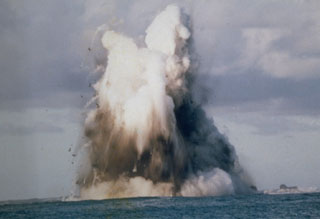Report on Nishinoshima (Japan) — 20 June-26 June 2018
Smithsonian Institution / US Geological Survey
Weekly Volcanic Activity Report, 20 June-26 June 2018
Managing Editor: Sally Sennert.
Please cite this report as:
Global Volcanism Program, 2018. Report on Nishinoshima (Japan) (Sennert, S, ed.). Weekly Volcanic Activity Report, 20 June-26 June 2018. Smithsonian Institution and US Geological Survey.
Nishinoshima
Japan
27.247°N, 140.874°E; summit elev. 100 m
All times are local (unless otherwise noted)
JMA reported that seismic, thermal, RADAR, and sulfur dioxide data all showed no eruptive activity at Nishinoshima since mid-August 2017. During an overflight on 14 June the Japan Coast Guard noted white fumarolic plumes rising about 20 m from the E side of main cone’s inner wall and from the center of the crater. Ocean water all around the island was discolored, especially in the N-to-NW quadrant where the yellowish brown water extended 200-300 m from the shore. On 20 June the JMA reduced the warning level for the island, specifying hazards were less severe “around the crater” (encompassing areas within 500 m).
Geological Summary. The small island of Nishinoshima was enlarged when several new islands coalesced during an eruption in 1973-74. Multiple eruptions that began in 2013 completely covered the previous exposed surface and continued to enlarge the island. The island is the summit of a massive submarine volcano that has prominent peaks to the S, W, and NE. The summit of the southern cone rises to within 214 m of the ocean surface 9 km SSE.

